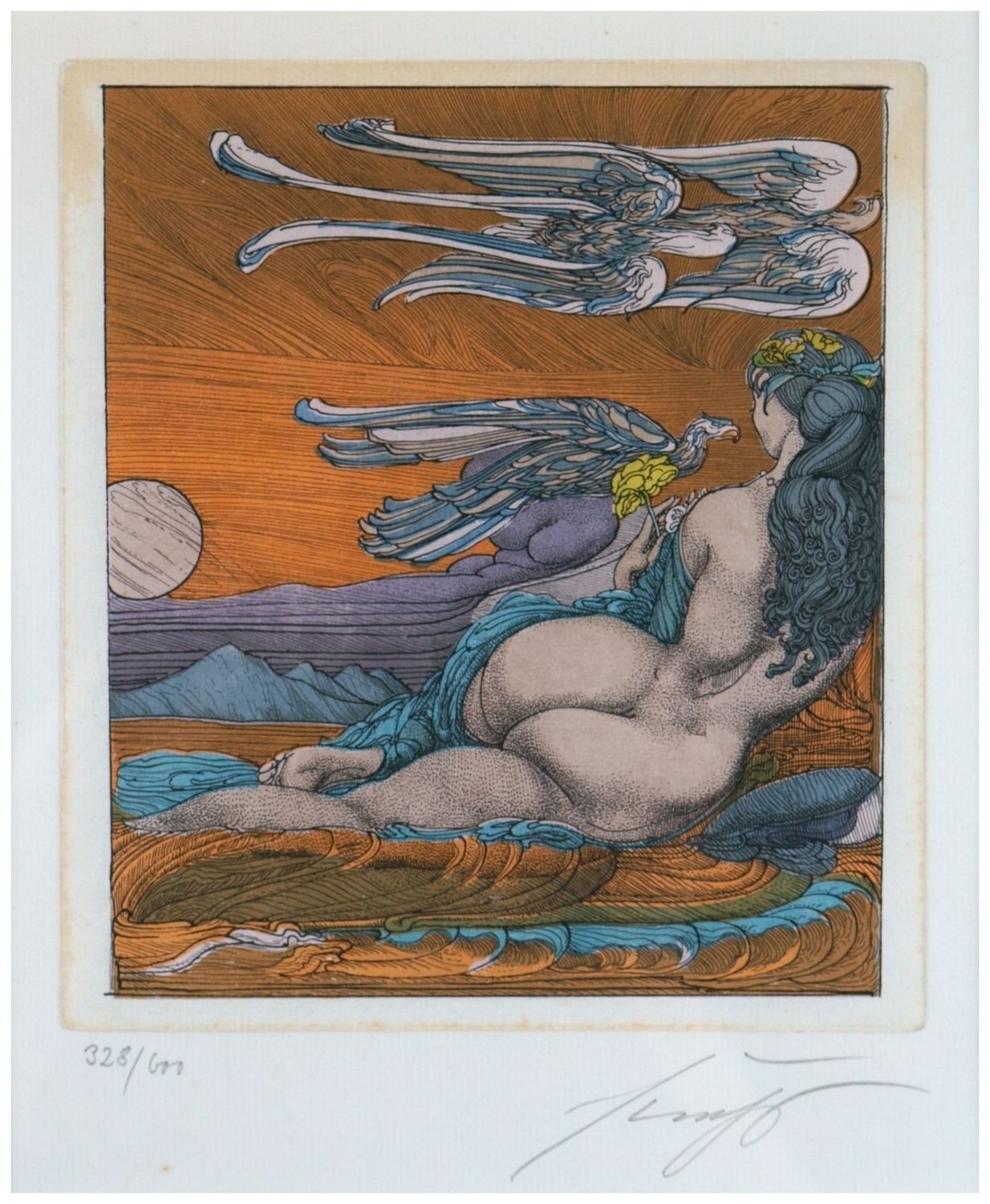Fuchs, Ernst (1930-2015), Bachnymphe, 1976
Ernst Fuchs(1930 Wien - 2015 Wien), Bachnymphe , 1976. Farbradierung, 19,2 x 16,7 (Darstellung), 39,5 x 35,5 (Rahmen), in Blei mit „Fuchs“ signiert und als Exemplar „328/600“ nummeriert. Werkverzeichnis Hartmann/Weis Nr. 261a. Im Passepartout unter Glas gerahmt.
- Rahmen mit kleinerer beriebener Stelle, sonst in sehr gutem Zustand
- Fließende Weiblichkeit -
Von Wellenbewegungen umflossen lagert die Bachnymphe, mit uns zugewendetem Rücken, auf einer Art Insel. Ihr bilddurchmessender Körper bietet sich wie eine Landschaft dar, die ebenfalls ganz von fließenden Bewegungen bestimmt wird. Ihr Haar fällt kaskadenartig hinab, wobei die Locken wie kleine Wasserstrudel wirken. Auch die blaue Farbe des Haars gemahnt ebenso an Wasser wie das türkisfarbene Gewand, das sie mehr enthüllt als verdeckt. Das Gewand entspricht farblich den Wellenkronen. Die Nymphe scheint sich mit dem Wasser selbst zuzudecken, was dem Bild ein surreal-phantastisches Moment verleiht. Ebenso phantastisch wirken die gleichfalls in fließenden Lineaturen gehaltenen Vögel, von denen sich einer der Nymphe zuwendet, die sich ihrerseits vom Kissen aufrichtet.
Die Vögel stehen für das himmlische Element und ergänzen das Element des Wassers. Ist das Wasser der Weiblichkeit zugeordnet, so stehen die Vögel für die dazu komplementäre Männlichkeit. Beide Prinzipien begegnen sich im innigen Blick von Vogel und Nymphe und sind durch die gelbe Blüte miteinander verbunden. Die Verbundenheit geht in der Formensprache des Phantastischen aber noch darüber hinaus: Die violetten Wolken des Hintergrundes bilden unter dem Vogel den – nun uns zugewendeten – Körper der Nymphe aus.
Neben der Wolkenbildung zeigt sich der Mond. Er verbindet die Nymphe mit Diana und weist die Landschaft als ihr Reich aus, das von den Vögeln durchzogen wird. Und dennoch ist die vom Eros durchwaltete Komplementarität des Weiblichen und Männlichen der wesentliche Bildgehalt, der sich auch im Blau-Orange-Kontrast widerspiegelt und von Fuchs in seinem Oeuvre in immer neuen Aspekten zur Darstellung gebracht, dadurch vertieft und entfaltet wird.
zum Künstler
Der junge Ernst Fuchs wählt als Taufnamen ‚Ernst Peter Paul‘, eine Reverenz des gerade einmal Zwölfjährigen an Peter Paul Rubens, der ihn immer wieder inspirieren sollte. Ein erster künstlerischer Unterricht wurde ihm durch den Bruder seiner Taufpatin, Alois Schiemann, zuteil. Später besuchte er die Malschule St. Anna in Wien und 1946 wurde er in die Wiener Akademie der bildenden Künste aufgenommen, wo er unter Robin Andersen und Albert Paris Gütersloh, dem geistigen Vater der Wiener Schule des Phantastischen Realismus bis 1950 studierte. Nach zahlreichen Reisen hielt sich Fuchs länger im Dormitio-Kloster am Berg Zion in Israel auf, wo er sich intensiv mit der ihn prägenden Ikonenmalerei und der damit verbundenen spirituellen Maltechnik beschäftigte. In seinem Buch Architectura Caelestis (1966) teilt er mit, dass viele seiner Motivfindungen auf visionären Erfahrungen basieren, was er später abermals hervorhebt:
„Nicht selten gelange ich während des Malens in Trance, mein Bewusstsein schwindet zugunsten eines medialen Schwebezustandes, in dem ich mich von sicherer Hand geführt und bewegt fühle, Dinge tuend, von denen ich bewußtermaßen wenig weiß. Dieser Zustand kann mitunter mehrere Stunden dauern. Danach erscheint mir alles, was ich in diesem Zustand geschaffen habe, als ob ein anderer es getan hätte.“
- Ernst Fuchs
1962 kehrte Fuchs nach Wien zurück, wurde zum Professor an der Akademie berufen und zum wohl einflussreichsten Protagonisten der Wiener Schule des phantastischen Realismus, die 1959 im Belvedere ihre erste Gruppenausstellung präsentiert hatte. Neben Ernst Fuchs waren Arik Brauer, Rudolf Hausner, Anton Lehmden, Helmut Leherb und Güterslohs Sohn, Wolfgang Hutter, Hauptvertreter dieser Kunstströmung.
1972 erwarb Fuchs die Otto-Wagner-Villa, die er in kongenialer Weiterführung des Wiener Jugendstils zu seinem Privatmuseum gestaltete. In den 70er Jahren entwickelte sich auch die Künstlerfreundschaft mit Salvator Dalí und Arno Breker, die Dalí 1975 in die Worte fasste: „Wir sind das Goldene Dreieck der Kunst: Breker-Dalí-Fuchs. Man kann uns wenden, wie man will, wir sind immer oben.“
Fuchs bestätigte sich auch als Sänger spiritueller Lyrik und widmete sich ab den 1990er Jahren zusehends seiner phantastischen Architektur. Die in der Otto-Wagner-Villa verfolge Idee eines Gesamtkunstwerks schlug sich auch in der Gestaltung von Gebrauchsgegenständen nieder. So wurde ein BMW 635 CSi nach seinem Entwurf zum „Feuerfuchs auf Hasenjagd" und die Porzellanmanufaktur Rosenthal fertige zahlreiche Produkte nach seinen Vorlagen an.
In seiner Kunst schöpft Ernst Fuchs aus der Fülle der Tradition, aus der sein Genius eine ganz neue Semantik gebiert:
„Erkenntnisse suchen mich heim, die zu finden ich gar nicht gehofft hatte. Von dieser Geistlichkeit erfasst, begreife ich auch, was die großen Erkenntnisse anderer Maler waren, die meine Bewunderung erregten. Ein Verständnis der Kunst und der Erkenntnis, die sie vermittelt, erfasst mich, so, als ob mein Geist mit allen Künstlern aller Epochen in einen Diskurs geraten wäre.“
- Ernst Fuchs
Auswahlbibliographie
Quelltexte
Ernst Fuchs: Architectura Caelestis - Images Of The Hidden Prime Of Styles (Die Bilder des verschollenen Stils), Frankfurt a. M. 1966.
ders.: Im Zeichen der Sphinx. Schriften und Bilder. Hrsg. v. Walter Schurian, München 1978.
ders.: Aura. Ein Märchen der Sehnsucht, München 1981.
ders.: Phantastisches Leben. Erinnerungen, Berlin 2001.
Werkverzeichnis
Helmut Weis: Ernst Fuchs. Das graphische Werk. 1967 - 1980, München 1980.
Literatur
Gerhard Habarta: Ernst Fuchs. Das Einhorn zwischen den Brüsten der Sphinx. Eine Biographie, Graz 2001.
Friedrich Haider (Hrsg.): Ernst Fuchs. Zeichnungen und Graphik aus der frühen Schaffensperiode mit Hinweisen auf die Malerei 1942-1959, Wien 2003.
Agnes Husslein-Arco (Hrsg.): Phantastischer Realismus. Arik Brauer, Ernst Fuchs, Rudolf Hausner, Wolfgang Hutter, Wien 2008.

